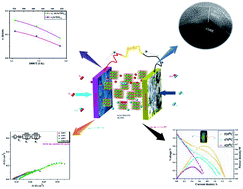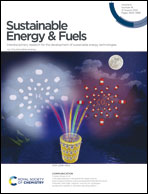Perovskite Al-SrTiO3 semiconductor electrolyte with superionic conduction in ceramic fuel cells†
Abstract
Perovskite oxide doping may modulate the energy bandgap strongly affecting the oxygen reduction activity and electrical properties with high promise for use as a low-temperature solid oxide fuel cell (LT-SOFC) electrolyte. Here, we show that a small amount of Al-doping into SrTiO3−δ may tune the energy band structure of SrTiO3−δ, triggering the electrochemical mechanism and fuel cell performance. The synthesized SrTiO3−δ and Al-SrTiO3−δ electrolytes are sandwiched between two symmetrical electrodes (Ni foam pasted NCAL). Ni-NCAL/SrTiO3−δ/NCAL-Ni and Ni-NCAL/Al-SrTiO3−δ/NCAL-Ni structures delivered a maximum power density of 0.52 W and 0.692 W and high ionic conductivity of 0.11 S cm−1 and 0.153 S cm−1, respectively, under H2/Air atmosphere at low operational temperature of 520 °C. Highways of ion transport along the surface and grain boundary (interface) are identified as the main reason for good oxygen ion conduction. X-ray diffraction (XRD), scanning electron microscopy (SEM), high-resolution transmission electron microscopy (HR-TEM), UV visible (UV), and X-ray photoelectron spectroscopy (XPS) were performed to investigate the structural, electrochemical, morphological, surface and interfacial properties of Al-SrTiO3−δ. The obtained results suggest that a certain amount of Al (20%) doping into SrTiO3 (SrTi0.8Al0.2O3−δ) improves the fuel cell performance and is a promising electrolyte candidate for LT-SOFC.



 Please wait while we load your content...
Please wait while we load your content...